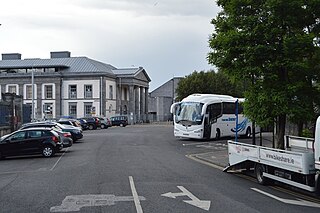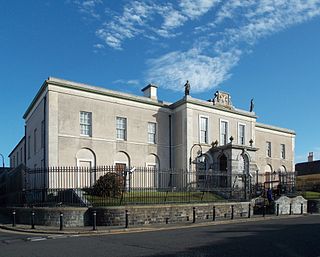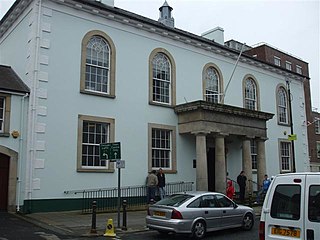
The Omagh bombing was a car bombing on 15 August 1998 in the town of Omagh in County Tyrone, Northern Ireland. It was carried out by the Real Irish Republican Army, a Provisional Irish Republican Army (IRA) splinter group who opposed the IRA's ceasefire and the Good Friday Agreement, signed earlier in the year. The bombing killed 29 people and injured about 220 others, making it the deadliest incident of the Troubles in Northern Ireland. Telephoned warnings which did not specify the location had been sent almost forty minutes beforehand, and police inadvertently moved people toward the bomb.

The Royal Courts of Justice in Chichester Street, Belfast is the home of the Court of Judicature of Northern Ireland established under the Judicature Act 1978. This comprises the Northern Ireland Court of Appeal, High Court of Northern Ireland and the Crown Court in Northern Ireland. It is a Grade A listed building.

The Crumlin Road Courthouse is a former judicial facility on Crumlin Road in Belfast, Northern Ireland. It is a Grade B+ listed building.

Armagh Courthouse is a judicial facility in Armagh, County Armagh, Northern Ireland. The courthouse, which accommodates hearings for the local magistrates' courts and county courts, is a Grade A listed building.
This is a chronology of activities by the Provisional Irish Republican Army (IRA) from 1980 to 1989. For actions before and after this period see Chronology of Provisional Irish Republican Army actions.

Cavan Courthouse is a judicial and municipal facility in Farnham Street, Cavan, County Cavan, Ireland.

Tralee Courthouse is a judicial facility in Ashe Street, Tralee, County Kerry, Ireland.

Longford Courthouse is a judicial facility in Main Street, Longford, County Longford, Ireland.

Dundalk Courthouse is a judicial facility in Dundalk, County Louth, Ireland.

Monaghan Courthouse is a judicial facility in Monaghan, County Monaghan, Ireland

Tullamore Courthouse is a judicial facility in Tullamore, County Offaly, Ireland

Limerick Courthouse is a judicial facility at Merchant's Quay, Limerick, County Limerick, Ireland.

Waterford Courthouse is a judicial facility in Catherine Street, Waterford, County Waterford, Ireland.

Downpatrick Courthouse is a judicial facility on English Street, Downpatrick, County Down, Northern Ireland. The courthouse, which served as the headquarters of Down County Council from 1878 to 1973, is a Grade B+ listed building.

Enniskillen Courthouse is a judicial facility in East Bridge Street, Enniskillen, County Fermanagh, Northern Ireland. It is a Grade B listed building.

The Bishop Street Courthouse is a judicial facility in Bishop Street, Derry, County Londonderry, Northern Ireland. It is a Grade A listed building.

The Old Courthouse is a former judicial facility on Castlerock Road in Coleraine, County Londonderry, Northern Ireland. It is a Grade B1 listed building.

County Hall is a municipal facility in Drumragh Avenue, Omagh, County Tyrone, Northern Ireland. It served as the headquarters of Tyrone County Council from 1962 to 1973.

County Buildings is a municipal facility in East Bridge Street, Enniskillen, County Fermanagh, Northern Ireland. It served as the headquarters of Fermanagh County Council from 1960 to 1973.

Charlemont Place is a row of terraced houses in Armagh, County Armagh, Northern Ireland. The buildings served as the headquarters of Armagh County Council from 1945 to 1973. They are all Grade A listed buildings.




















